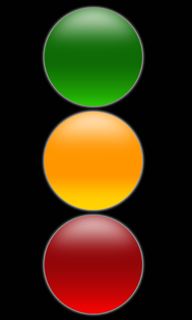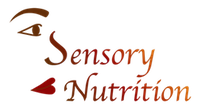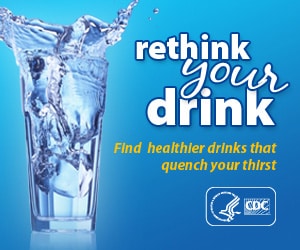 Since it’s officially Summertime, the temperatures are rising around the United States, and in many cases, so is the humidity. Such weather reminds us of the 3 H’s–Heat, Humidity, Haze –so typical of August, but which often also strikes as early as June or July!
Since it’s officially Summertime, the temperatures are rising around the United States, and in many cases, so is the humidity. Such weather reminds us of the 3 H’s–Heat, Humidity, Haze –so typical of August, but which often also strikes as early as June or July!
Everyone wants to cool down when it gets so hot outdoors, so it is time to properly hydrate. IF you have a medical condition that your health care professional is treating you for, then of course follow their advice, but otherwise for healthy folks the following “Go On Green” approach being advocated by government programs nationwide could work out well for you.
(Inverted traffic light image courtesy of rizeli53 at rgbstock.com)
Note that you should grab water, NOT sugar-laden beverages in most cases, to optimally hydrate in summertime. Carry your own bottle of water and refill it appropriately throughout the day. Cool (not cold) potable water or possibly even seltzer or maybe fat-free/skim or low-fat milk type beverages (no sugar added) are among your best choices as the temperature rises. There are insulated water bottles or sleeves to slip on over other water bottles to help keep the water cool and refreshing.
There are other good options to replace water losses and some less desirable ones–let’s discuss a few of both of these.
Other options for consumption to help replace water losses as is appropriate for any individual can include fruit sources from fruits to 100% fruit juices with no added sugar to home frozen juice popsicles; vegetable sources including fresh vegetables, “cold” type vegetable soups without a lot of added sodium, or mixtures of 100% total fruit juices + 100% vegetable juices without added additional caloric contributing sweeteners and without a lot of added sodium; sugar-free and low-calorie beverages such as some bottled teas or some diet sodas or some diet drink mixes, etc.
Really think thrice before grabbing for the least desirable choices–you are best off drinking them rarely, if at all–which include beverages that claim to be a fruit drink (yet are mainly sugar and NOT mainly fruit juice), regular sodas, and sports drinks (you should discuss the use of any sports drinks with your health care provider, especially ideally a Registered Dietitian). You could also add to the list of least desirable choices any sugar sweetened “iced coffees” out there, sugary “Southern Ice Tea” or other sugar-laden drink mixes, and even frozen flavored sugar syrup “ices” and the like as well.
Actually the City of Boston has a nice “traffic light” theme guide to help folks who want to “rethink your drink.” The green for “Go on Green” traffic light symbol (along with the yellow and red symbols) can help to clarify an approach that makes sense for the average healthy American. They urge people to “STOP. Rethink Your Drink. Go On Green” and really take a moment to think about the choices they are making before they reach for something to help refresh themselves not only in hot weather, but year round.
Here is the “short” list for each color code:
Green – Drink Plenty
- Water
- Seltzer water
- Skim or 1% milk
Yellow– Drink Occasionally
- Diet soda
- Low-calorie, low-sugar drinks
- 100% juice
Red – Drink Rarely, If At All
- Regular sodas
- Energy or sports drinks
- Fruit drinks (these are NOT all juice, and some contain merely 10% juice or NO juice at all!)
——————————————————————————————
[Here is the “Long” list for each color code:
Green – Drink Plenty (as it is the healthiest choice at 0 to 5g of sugar per 12 oz)
“Green” beverages have no added sugars and articial sweeteners. These are the healthiest choices, especially tap water. Water hydrates the body, quenches thirst, and supports other bodily functions necessary for overall health. Low-fat milk contains natural sugars and healthy nutrients. It should be consumed in portions that are 8 oz or less.
- Water
- Seltzer water
- Skim or 1% milk
- Unsweetened soymilk
Yellow– Drink Occasionally (as it is a mid-range choice at 6 to 12g of sugar per 12 oz or may contain articial sweeteners)
“Yellow” beverages have moderate amounts of sugar and sodium, or contain artificial sweeteners. 100% fruit juice and flavored low-fat milk may have more than 12 grams (g) of sugar because they contain natural sugars, but may still be consumed in small portions of 8 oz or less because they contain important nutrients. Diet and “light” drinks that are artificially sweetened may increase taste preferences for sweet foods and drinks, which contribute to weight gain. Diet drinks can be used as a way to switch from RED choices to GREEN choices.
- Diet soda
- Diet ice tea
- Some Lo-cal sports drinks
- Some small portions sweetened soymilk
- Small portions flavored 1% milk
- Low-calorie, low-sugar drinks
- 100% juice in smaller portions (try mixing part juice with part ice)
Red – Drink Rarely, If At All (STOP and THINK as it is a choice containing over 12g of sugar per 12 oz)
“Red” beverages are high in sugar. Many also have high sodium and/or fat content. Red drinks contain “empty”calories, with little or no nutrients, and can contribute to weight gain and other chronic diseases like Type 2 diabetes and heart disease.
- Regular sodas
- Energy Drinks
- Sports drinks
- Pre-sweetened coffee and tea drinks
- Fruit drinks (these are NOT all juice, and some contain merely 10% juice or NO juice at all!)
- Whole or 2% milk (consumed by older children & adults)]
——————————————————————————————
The Centers for Disease Control (CDC) and the Department of Health and Human Services (USDHHS) initially brought out the program of “Rethink Your Drink” in conjunction with the Healthy Eating for a Healthy Weight initiative to encourage people to cut out excess calories that don’t provide needed valuable non-caloric nutrients to the body hoping to bring high sugar content drink consumption to the attention of Americans. Many programs around the country have been continuing to focus in on this important initiative ever since.
The majority of sugar laden beverages are simply providing “empty calories” without the benefit of desirable additional nutrients other beverage choices could potentially provide. People need to watch portion sizes, too, when consuming anything caloric, including beverages.
It is easy to consume 2-3 or more servings of a caloric beverage without even realizing it because so many bottles, etc., that are sold are “super-sized” these days and are 20 oz, 30 oz, or more in size. In other cases, people are grabbing for more juice boxes than they may really need instead of consuming other food items such as actual whole or cut-up pieces of fresh fruits or fresh vegetables that are water-rich along with being great sources of other nutrients as well. Keep in mind in a “no good choices” scenario that it might be an option for a healthy person to order a child size container of a less desirable beverage until one could find refreshing potable water again.
The Cook County Department of Public Health has urged citizens in the Chicago area to be smarter about what they drink. Some key points they have been reminding people of include:
- Nearly 50% of the average American’s increased calorie consumption is from sugar-loaded beverages.
- Sugar-loaded beverages are the single major source of added sugar consumed by the average American
- Drinking one larger soda a day (equal to two smaller sodas) can equal an extra 25 pounds of weight per year
- Drinking Sports and Energy drinks can lead to obesity, heart disease and diabetes
- There are 16-18 teaspoons of sugar in a 20 oz. soda
Here’s a snapshot from the government materials (numbers copied exactly so please treat the figures as only approximate as we noted some duplication of numbers indicating there may be some typographical errors in the original) to help highlight all the unnecessary calories present in some beverage choices that are out there.
Type of Beverage Kcal in 12 oz Kcal in 20 oz
Fruit punch 192 320
100% apple juice 180 300
100% orange juice 168 280
Lemonade 168 280
Lemon/lime soda 148 247
Regular cola 136 227
Bottle Sweetened iced tea 135 225
Tonic water 124 207
Regular ginger ale 124 207
Sports drink 99 165
Fitness water 18 36
Unsweetened iced tea 2 3
Diet soda 0* 0*
Carbonated water 0 0
Water 0 0
*Some diet soft drinks can contain a small number of calories that are not listed on the nutrition facts label.
(USDA National Nutrient Database for Standard Reference)
Do yourself a favor and take time to “Rethink Your Drink” and really consider what types and amounts of liquids you want to choose to refresh yourself and want to have on hand for family and friends to refresh themselves with as well.
Your choice of drink really does matter!


